Creating a Strong Multifamily Brand Identity Starts with the Right Name — Here’s How We Do It
Naming a new property is no small task. Whether it’s a residential complex, a mixed-use space, or a multifamily development, the right name can define the property’s identity, marketability, and overall brand experience. At Criterion.B, we understand the intricacies of multifamily branding, and naming is one of the most important aspects of crafting a property’s brand story.
As a multifamily branding agency, we recognize that the name isn’t just a label — it’s the first impression potential tenants or investors will have of your property. It’s what makes your property memorable, what makes it stand out in a competitive market, and ultimately, what helps shape its story.

Here’s a deeper look into the process of naming a property and how our multifamily brand identity expertise can help you create a lasting impression.
The Blueprint for a Strong Name
Before brainstorming names, we take a critical step that sets the foundation for everything else: understanding the property’s brand strategy. This is where multifamily branding and brand creation meet. The brand strategy guides us through the vision, goals, and key messaging of the property, ensuring that the name we choose aligns with the overall brand development.
With a clear brand strategy, we look at the property’s unique story. Is it a vibrant urban community, a serene retreat in nature, or an industrial-inspired space that speaks to creativity? Knowing the property’s essence helps us establish a name that speaks to its core identity.
This process goes beyond mere creativity — it’s about marrying imagination with strategy. A name should evoke the feelings we want prospective residents to associate with the property. It’s not just about being catchy; it’s about telling the property’s apartment brand story in a single word or phrase.
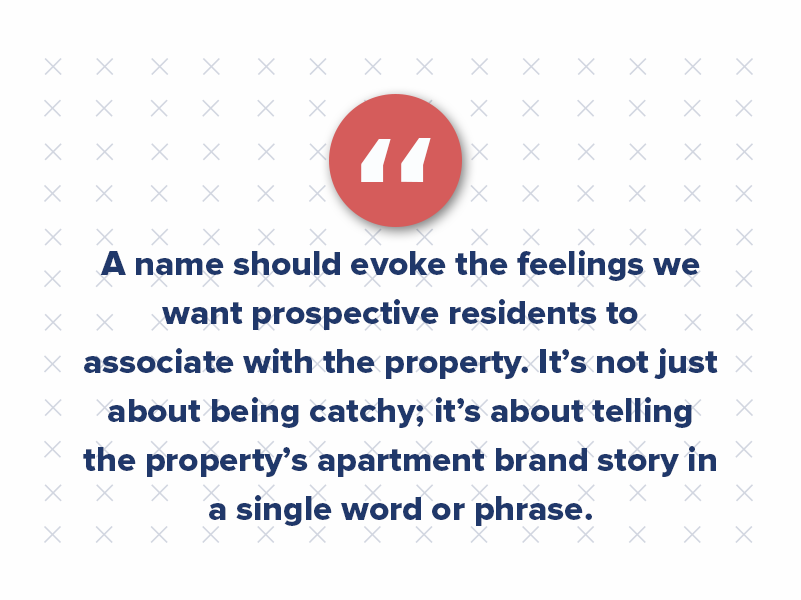
Brainstorming: The Creative Phase
Once we have the foundational strategy, we dive into the creative phase of naming. We don’t just pick names out of thin air — we carefully curate options from different branding categories. For multifamily projects, we typically explore four broad naming buckets:
- Local Influence: Drawing inspiration from the surrounding neighborhood or city can create a strong connection to the community. It brings authenticity and relevance to the name, making it more relatable to future residents.
- Architectural Style: Names that reflect the design and aesthetic of the property can help reinforce the property’s personality. Whether it’s modern, historical, or industrial, the name should mirror the physical environment.
- Lifestyle Appeal: Properties often attract tenants who are looking for a specific way of life, such as luxury living or a family-friendly environment. A name that speaks to lifestyle appeals directly to your target market.
- Natural Elements: For properties with scenic surroundings or a focus on green living, incorporating nature-inspired elements into the name can create a sense of tranquility and community.
Within each of these buckets, we generate a wide range of options, from the more traditional to the avant-garde, ensuring we have a robust selection of potential names. This helps us assess what truly resonates with the property’s vision and its future residents. As a multi-family branding agency, we pride ourselves on offering diverse options, each with a purpose.
The Vetting Process: Where Strategy Meets Practicality
Choosing the right name isn’t just about creativity. It’s also about strategy, so we carefully vet every name option. We use a multi-step process that includes:
- Trademark Availability: We ensure that the name doesn’t conflict with existing trademarks or businesses. A name might sound great, but it’s important to make sure it’s legally available and won’t cause issues down the road.
- SEO & Digital Viability: We research the SEO potential of the name, analyzing whether it’s too generic or oversaturated in search results. A name should not only be easy to remember but also help drive organic traffic to the property’s apartment website design.
- Domain Name & Social Media Handle: The availability of a matching domain name and social media handles is crucial. The property name needs to translate seamlessly into digital spaces, whether it’s the property’s website or Instagram page.
Once the names pass these tests, we narrow down the list and meet as a team to collaborate and think through which names are best. We always review multiple options spanning a range of tones and styles, ensuring there’s something for every preference.
Collaborative Naming
Naming a multifamily property is a collaborative process where creativity and strategic thinking intersect. We bring together a diverse team of designers, marketers, and brand strategists to ensure every name option we consider has the potential to speak to the property’s unique identity. Each team member contributes 10-20 name ideas, and we engage in thoughtful discussions to narrow down the best options.
We share the rationale behind each name, voting and sometimes vetoing suggestions until we have a curated list representing the property’s essence. This collaborative process ensures that the names we present to the client are aligned with the property’s personality and poised for success in the marketplace.
Once we’ve selected the top name candidates, we understand the importance of integrating that name into the broader brand identity. A name is not just a word; it becomes part of the property’s visual branding and marketing materials.
From apartment brochures to website copy and social media, the name will appear across every piece of marketing collateral. This is why choosing the right name is so essential. It must resonate with the target market and align with the property’s customer experience.
A strong name becomes the foundation for creating a brand that stands out in a crowded market, creating a unique identity that draws potential customers in. In this sense, the name is more than just a label — it’s a key element in building compelling brands that impact every marketing material.
The name also plays a critical role in shaping the user experience from the first impression. Whether it’s part of a color palette, included in the branding guidelines, or featured in a social media campaign, the name becomes the first visual element that represents the multifamily community to prospective renters. As a critical part of the overall branding strategy, the name sets the tone for how the property will be perceived across all touchpoints.
Choosing a name that aligns with the market research and speaks to the target market’s needs ensures that every part of the branding ecosystem supports the goal of creating a strong, unique brand image that fosters positive engagement and lasting connections with potential customers.
The Final Selection: Refining and Testing
Choosing a name is a collaborative process. We present the top names, explaining the rationale behind each, and encourage our clients to weigh in. At this stage, we often work with clients to refine and polish the final selection. Does it feel like the property? Does it speak to the target demographic? Does it reflect the core apartment brand identity? We test and refine until we land on the perfect fit.
Once we have the name, we continue to build the brand around it. The name informs every aspect of the property’s branding and digital marketing strategy. From the apartment logo to the website design, to the messaging and tone used in advertising, the name sets the tone for everything that follows.
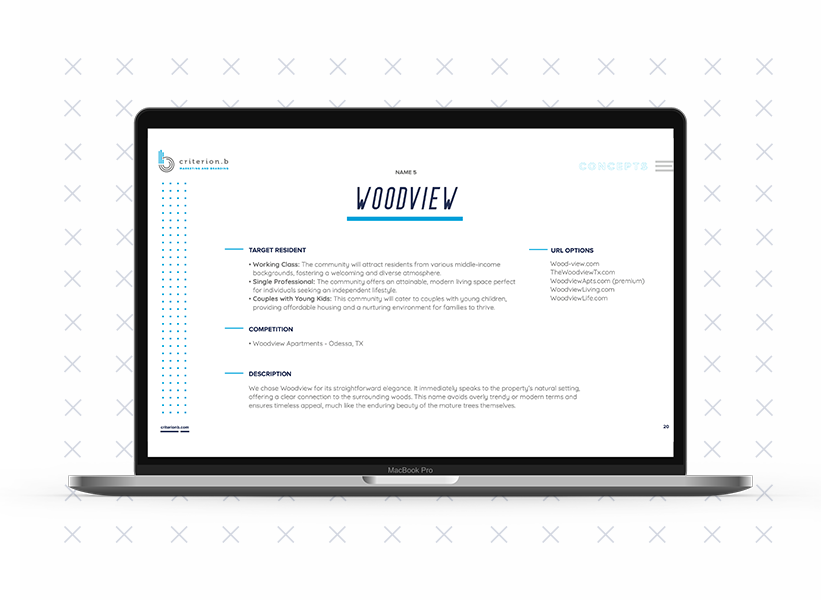
Building the Brand Around the Name
Once the name is chosen, the next step is creating a multifamily brand experience that aligns perfectly with the identity of the property. This phase is where the magic happens, and it’s all about ensuring that the name feels tangible and connected across all brand touchpoints.
As a leading branding and digital marketing agency, we know that creating a compelling multifamily brand story is crucial. The name is no longer just a word — it becomes the foundation for everything the property stands for, from its multifamily graphic design to the user experience across marketing channels.
Our approach involves taking the newly selected name and weaving it into every piece of marketing material, ensuring consistency and cohesion. Whether we are designing custom multifamily logos, curating social media content, or developing the graphic design for apartments, we place the property’s name at the center of all creative efforts. Every visual element (from the color palette to typography) is carefully selected to reflect the property’s personality and to resonate with the target market.

For multifamily communities, the name serves as the anchor of the property’s overall apartment brand experience, influencing not only the visual identity but also the tone of voice and messaging. As a Dallas branding agency, we understand the importance of creating a unique brand that stands out in a crowded market. This is why we prioritize strategic planning for every aspect of the branding process, ensuring that each brand element works in harmony to shape the perception of the property.
For a multifamily brand to thrive, it needs to translate across all marketing channels. From apartment websites that act as the property’s digital storefront to social media platforms where potential renters connect with the community, the brand must be adaptable, yet consistent.
Our team of experts, with experience in both branding and digital marketing, ensures that the branding vision extends seamlessly into the digital realm. Whether it’s creating a cohesive visual branding experience or writing content that aligns with the multifamily brand story, every effort contributes to fostering a deeper connection between the property and its future residents.
The Power of a Name
Choosing a name is more than just picking words — it’s the foundation of a multifamily brand identity that will define how the property is perceived by residents and prospects alike. With a strategic, creative approach, we help our clients build names that resonate, stand out, and create lasting impressions.
When you partner with a multifamily branding agency like Criterion.B, you’re not just getting a name; you’re building a powerful brand that will engage residents, drive traffic, and elevate your property’s presence in a competitive market. Whether you’re working on apartment branding, branding multifamily properties, or multifamily marketing campaigns, the right name can make all the difference.
Ready to craft the perfect name for your property? Let’s talk.

Multifamily Brochure Designs to Captivate Your Residents
A well-designed apartment brochure is more than just marketing material; it’s a powerful tool for generating leads and making a lasting impression on your target audience. It goes beyond simply providing contact information. It showcases your community’s unique lifestyle through eye-catching designs, detailed floorplans, and compelling content.

Here, we’ll explore some apartment brochure examples our team designed that excel in creativity, effectiveness, and overall design excellence.
From showcasing business cards that capture the essence of your multifamily brand to utilizing case studies that highlight the success of your multifamily marketing efforts, each example offers valuable insights into creating a brochure that resonates with potential residents.
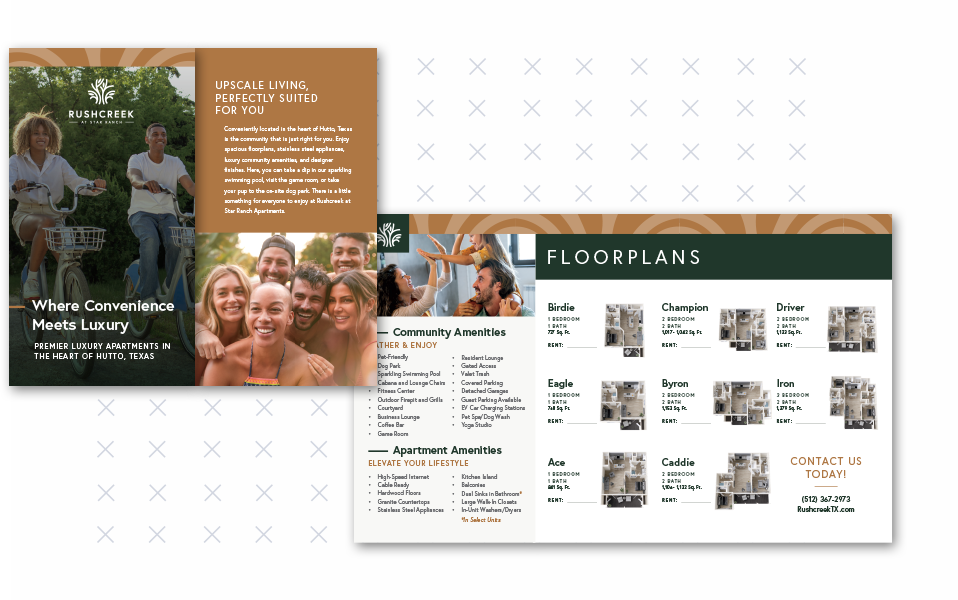
1. Rushcreek at Star Ranch
Rushcreek at Star Ranch in Hutto, Texas, is about comfort and usefulness. NE Property Management runs this apartment community. Their brochure showcases peaceful living, focusing on roomy interiors and modern perks. Warm colors and clear images invite people to imagine themselves in a cozy and comfortable home.
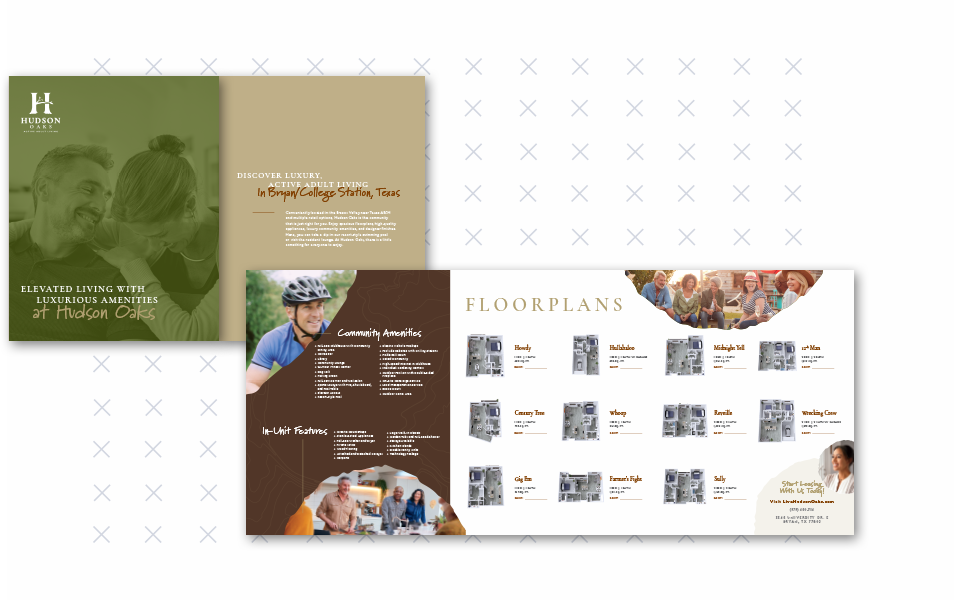
2. Hudson Oaks
Hudson Oaks is an active adult community in Bryan/College Station, TX. Life here is far from boring. The brochure for this NE Property Management property shows off the lively lifestyle with details about community events, fitness places, and social areas. The design mixes information and looks good, making it a great example of a good apartment brochure.
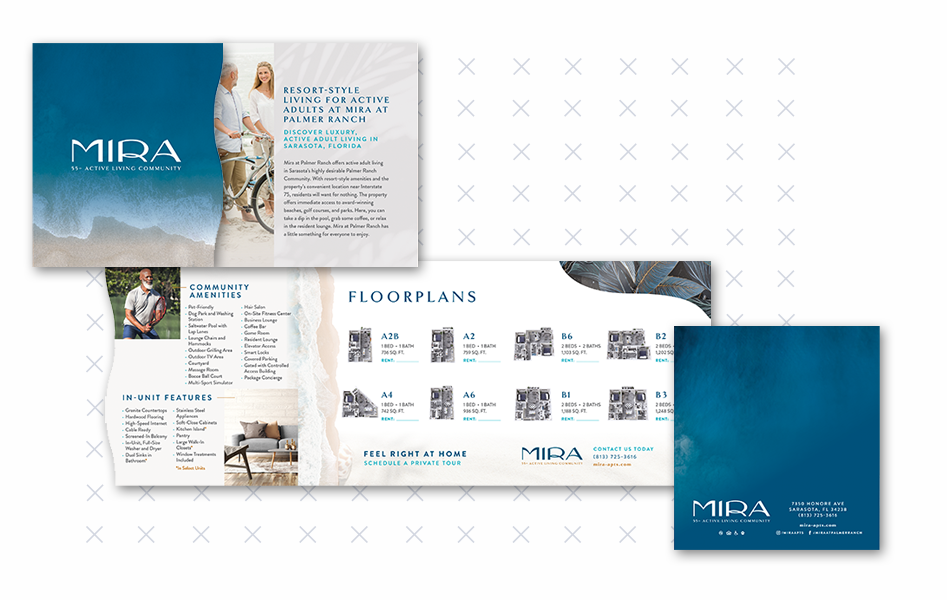
3. Mira at Palmer Ranch
Mira at Palmer Ranch in Sarasota, FL, is for active adults who want more from life. AG Spanos manages this 55-plus apartment community. Their apartment brochure has a fancy design that matches the property’s style. It focuses on luxury amenities and a lively community vibe, giving off a feeling of being special and refined.
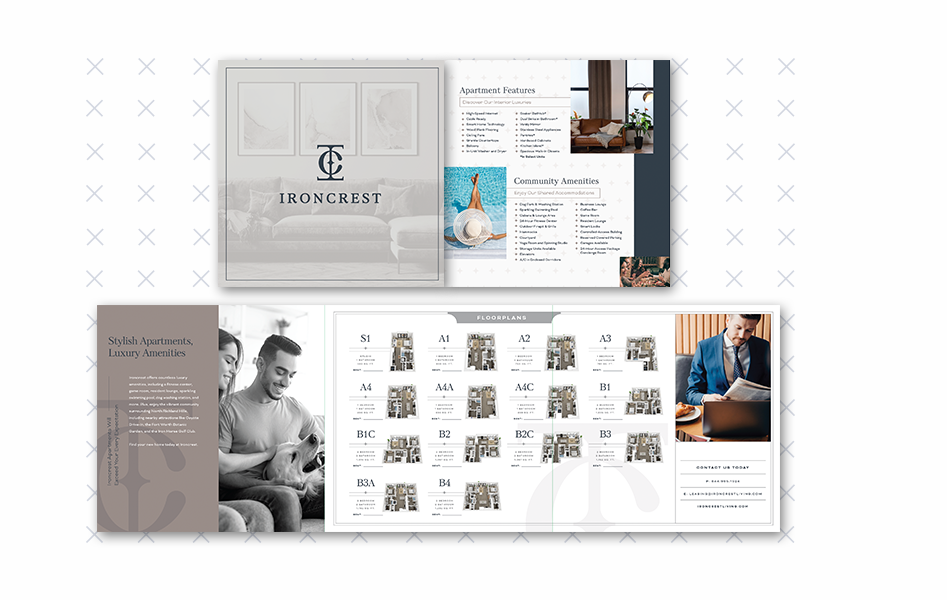
4. Ironcrest Apartments
Ironcrest Apartments, near Downtown Fort Worth in North Richland Hills, TX, offer city convenience and upscale living. AG Spanos manages this community. Their brochure has a sleek, modern design that fits the property’s classy look. Bold text and lively images show what this lively community is all about.

5. LynnCora Apartments
AG Spanos’ high-end community in Grand Prairie, Texas, LynnCora, needed an apartment brochure that showed its luxury offerings. The brochure is elegant and classy, from the name and apartment logo to the dynamic multifamily marketing materials. The design uses rich colors, classy fonts, and stunning visuals, making it an example of great apartment brochure ideas.
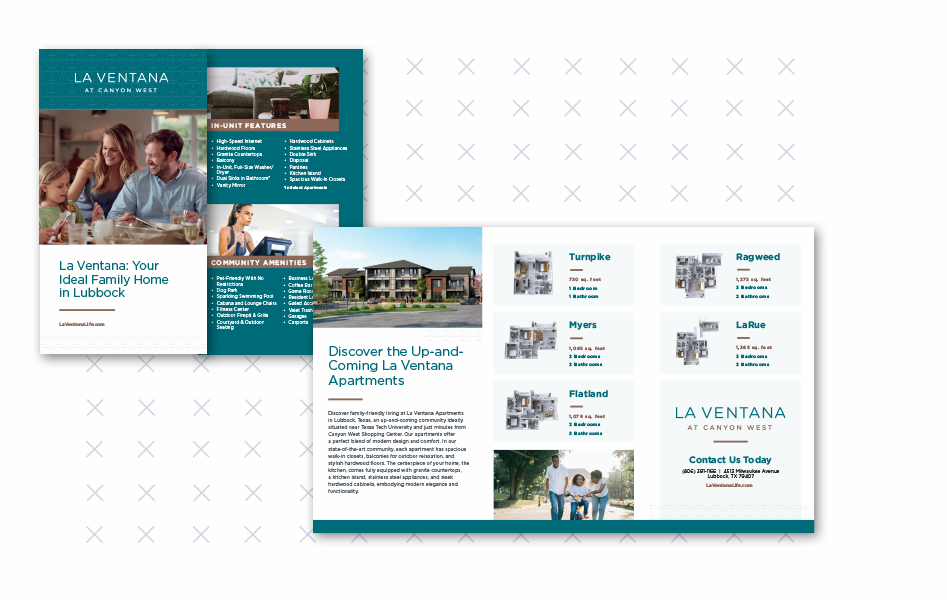
6. La Ventana at Canyon West
La Ventana at Canyon West in Lubbock, TX, is about luxury living. NE Property Management’s brochure is a lesson in apartment brochure design, showing off stylish insides and top-notch amenities. High-quality paper and a smart layout ensure potential residents get a visual and touchable experience matching the community’s upscale offerings.
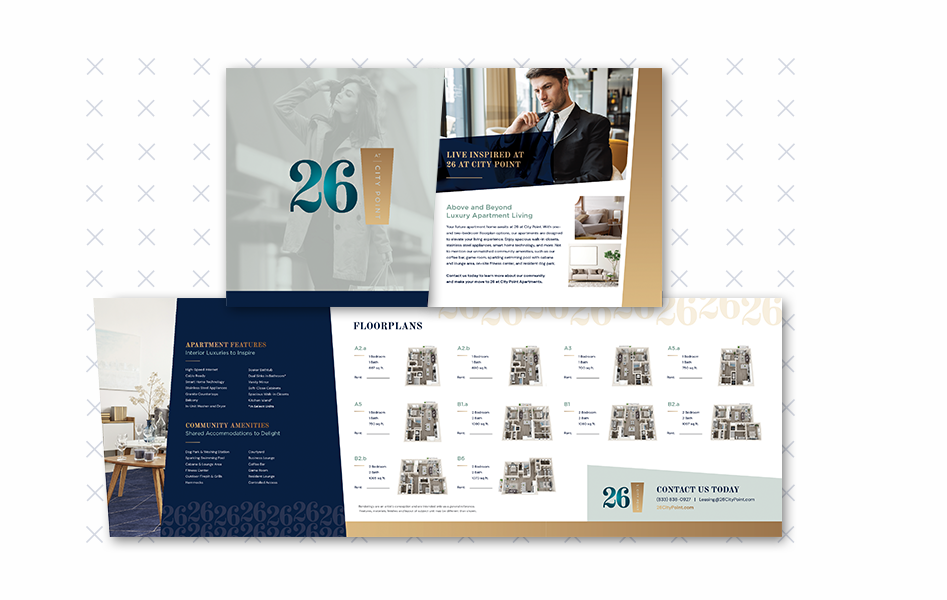
7. 26 at City Point
Adding to our list of noteworthy projects is our work with AG Spanos on the 26 at City Point apartment community. Our multifamily marketing agency was entrusted with creating a multifamily brand that mirrored the property’s sophistication and creativity. Through a collaborative process, we produced visuals that encapsulate a strong and distinct multifamily brand identity for the community.
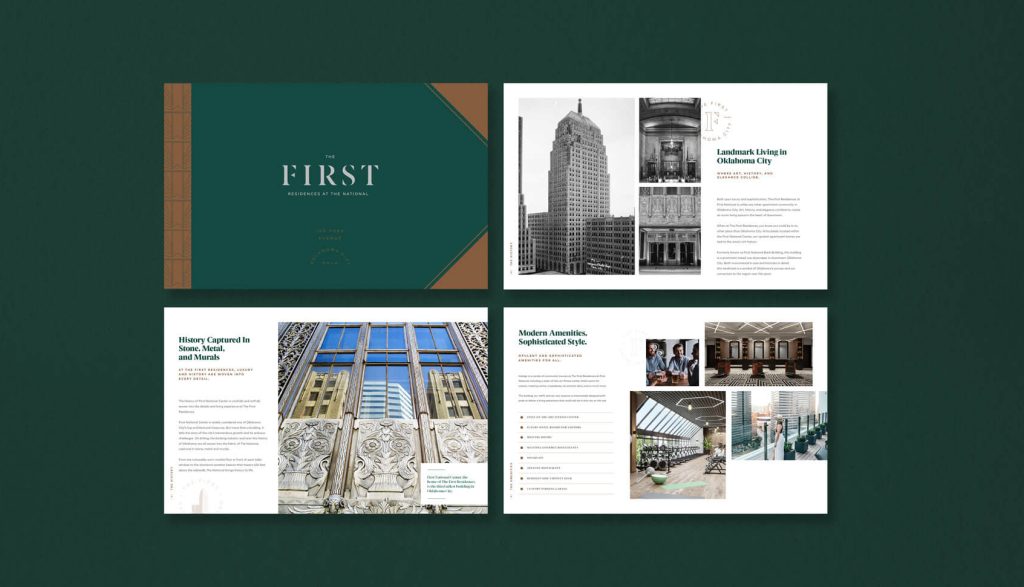
8. The First Residences at First National
Our work on The First Residences at First National showcases a brochure designed to immerse prospective residents in the property’s rich history and elevated living experience. Unlike a traditional apartment brochure, this piece goes beyond floorplans and amenities — it tells the story of the iconic First National Center building, highlighting its transformation into a premier residential destination. From fine dining and on-site entertainment to luxury services, every detail is thoughtfully crafted to reflect the unique lifestyle the building offers.
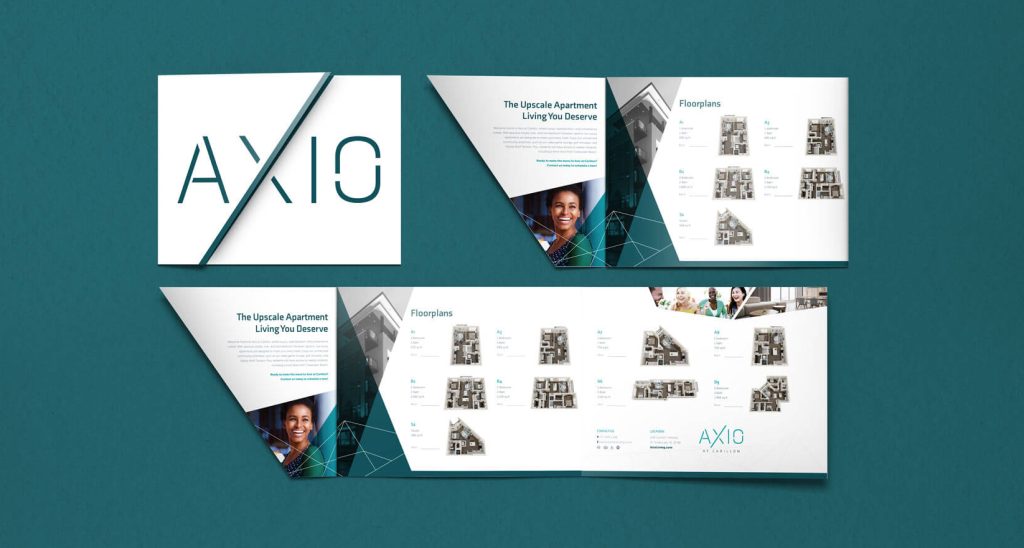
9. AXIO at Carillon
For AXIO at Carillon, we worked closely with AG Spanos to create a high-end apartment brochure that reflects the sophistication and energy of this Florida community. From the property’s sleek branding to the thoughtfully designed layouts, every element of the apartment brochure was crafted to highlight AXIO’s luxury amenities, vibrant location, and upscale living experience. The result is a visually compelling and informative piece that helps prospective residents envision life at AXIO at Carillon, reinforcing the brand’s modern and refined multifamily brand identity.
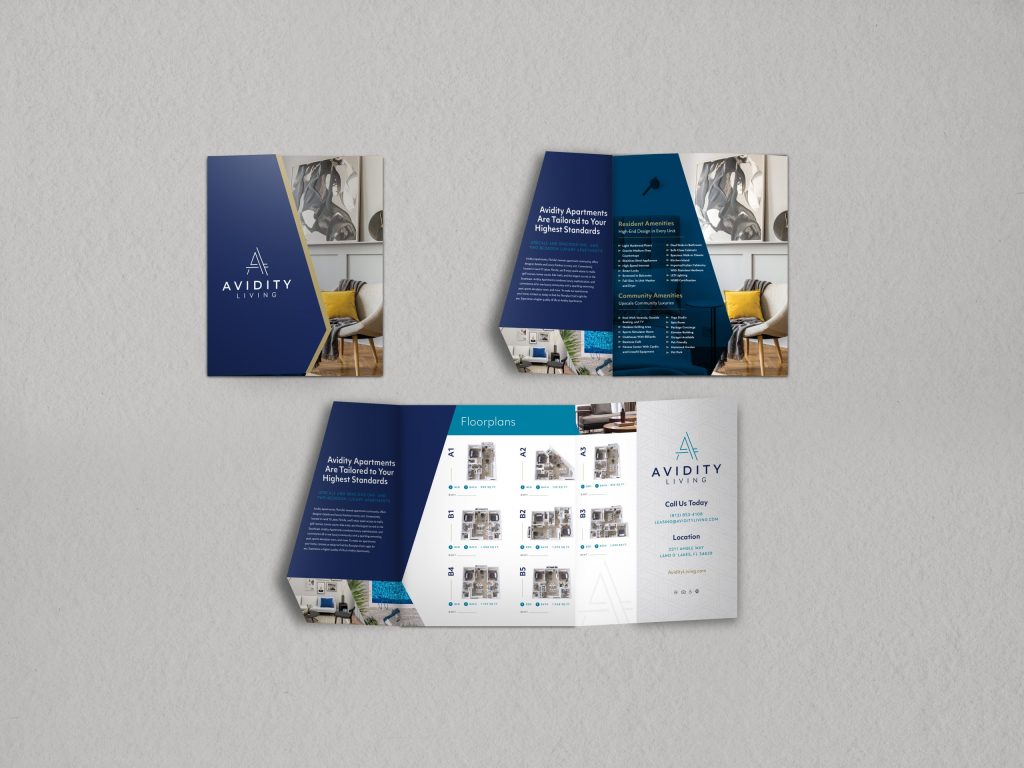
10. Avidity
For Avidity, we partnered with AG Spanos to create a standout apartment brochure that captures the dynamic energy and modern charm of this Land O’ Lakes community. From the carefully crafted logo to the sleek design elements, every part of the brochure was designed to showcase Avidity’s upscale amenities, prime location, and vibrant living experience. The result is a visually striking and informative piece that not only engages prospective residents but also reinforces Avidity’s distinctive multifamily brand identity. This project was honored with recognition from DesignRush as one of the Best Real Estate Print Designs.
The Power of Apartment Brochures
These apartment brochure examples demonstrate the power of high-quality print materials in the real estate industry. Well-designed brochures are more than just informative tools; they serve as critical pieces of multifamily marketing collateral that support a property manager’s marketing efforts. By highlighting key selling points and unique features, apartment brochures not only capture attention but also drive traffic to your property and aid in apartment lead generation.
A well-crafted brochure is a cornerstone of your content marketing strategy. It can complement other types of multifamily marketing collateral, such as business cards, white papers, and landing pages, to create a cohesive and comprehensive multifamily marketing plan. When integrated with digital marketing and online platforms like social media, these brochures work seamlessly with your online presence to elevate your marketing campaigns and reach potential renters across multiple channels.
Creating brochures that resonate with potential customers ensures your real estate business stands out in a competitive market. These materials highlight your community’s unique selling points, encouraging prospects to envision themselves living at your property. When designed strategically, brochures enhance your marketing tools by providing valuable information in a visually appealing format, leaving a lasting impression on future residents.
Apartment brochures also play a key role in your data-driven marketing strategy. By tracking engagement and measuring conversion rates, property managers can see how well their brochures are performing as part of the overall marketing mix. These insights help inform future campaigns, refining multifamily marketing strategies to optimize lease conversion and improve the effectiveness of community events or promotions.
Ultimately, the goal is to provide prospective residents with more than just a piece of paper—it’s about crafting an experience that complements your broader real estate marketing efforts. When done right, apartment brochures can serve as an invaluable asset in your multifamily marketing arsenal, helping you turn potential leads into long-term tenants while boosting your online presence and strengthening your property’s position in the multifamily industry.

Maximizing Your Multifamily Marketing Impact With Minimal Spend
In the face of economic uncertainty, slashing marketing budgets as a quick fix is tempting. However, such reactive measures can stifle your multifamily brand’s growth and diminish its visibility. Rather than retreating, we propose a strategic pivot: making your marketing budget work smarter, not harder.
This approach is about more than just surviving tough times; it’s about finding innovative ways to ensure your brand endures and flourishes.
Here’s how to ensure your brand thrives, even when the economy is not on your side.

1. Do your own market research.
Building a strong brand begins with understanding your market. It’s like trying to give a thoughtful gift without knowing the recipient’s interests; chances are, it will fail to hit the mark. Thorough market research is your compass in multifamily branding, guiding you to create a strategy that resonates with your target audience.
The good news is you don’t need a hefty budget to gain insights into your market. The digital age has blessed us with many tools to help you conduct adequate research without breaking the bank. Here are some accessible resources to kickstart your market research journey:
- Ubersuggest: This free tool offers valuable data on search volume and cost-per-click for any keyword, helping you identify what your audience is searching for.
- Facebook Analytics: Dive into the demographic details of your current users, such as age, gender, and location, to tailor your multifamily branding efforts.
- SurveyMonkey: Create custom surveys to gather direct feedback and insights from your potential customers.
- U.S. Census Data Tools: Estimate the reach of your product or service by understanding the population demographics.
- Google Analytics: Access a wealth of statistics and analytics across your website to inform your branding strategy.
- MailChimp: Utilize this free email marketing tool to create, send, and analyze email campaigns, helping you connect with your audience effectively.
By identifying your buyer persona and understanding their needs, you can fine-tune your brand’s design elements and messaging to meet their expectations. Armed with data-driven insights, you’ll be equipped to craft a multifamily brand that stands out and genuinely connects with your audience.
2. Create and maintain a solid multifamily brand identity.
The essence of a powerful brand lies not in extravagant gimmicks but in its ability to convey a company’s mission, values, and goals with clarity and conviction. Design, while crucial, is a means to an end — the end being the creation of a resilient multifamily brand identity that resonates with your audience.
Take a moment to reflect on what you want your brand to represent. Every element of your multifamily brand, from the logo to the messaging, should be a coherent part of a larger narrative that communicates your company’s ethos and the value it brings to customers.

With a focused approach and a well-defined goal, you can build a brand identity that rivals big-budget companies without the hefty price tag. It’s about leveraging what you have to craft a multifamily brand that speaks volumes and stands the test of time.
3. Go back to the basics of print marketing.
In an era dominated by digital screens, print marketing might need to be updated. Yet, it’s precisely this shift that makes print stand out.
Recent statistics reveal the enduring relevance of print in reaching key demographics. For example, 70% of households with an income above $100,000 are newspaper readers, and 95% of individuals under 25 engage with magazines. These figures underscore the potential of print media to connect with both affluent and younger audiences.
Print media also offers a level of engagement that digital platforms need help with matching. Readers typically spend 20 minutes or more immersed in their print publications, whereas the average visitor to a digital news site stays for less than five minutes. This extended exposure time can be invaluable for multifamily brands looking to make a lasting impression.
Print ads also have a cognitive advantage, requiring 21% less effort to process than their digital counterparts. This ease of comprehension can lead to higher retention and recall rates, making print an effective medium for conveying complex messages or detailed information.
Did you know that integrating print with digital campaigns can supercharge your marketing efforts? Studies suggest combining print and digital ads can make online campaigns 400% more effective, demonstrating the synergistic potential of a multi-channel approach.
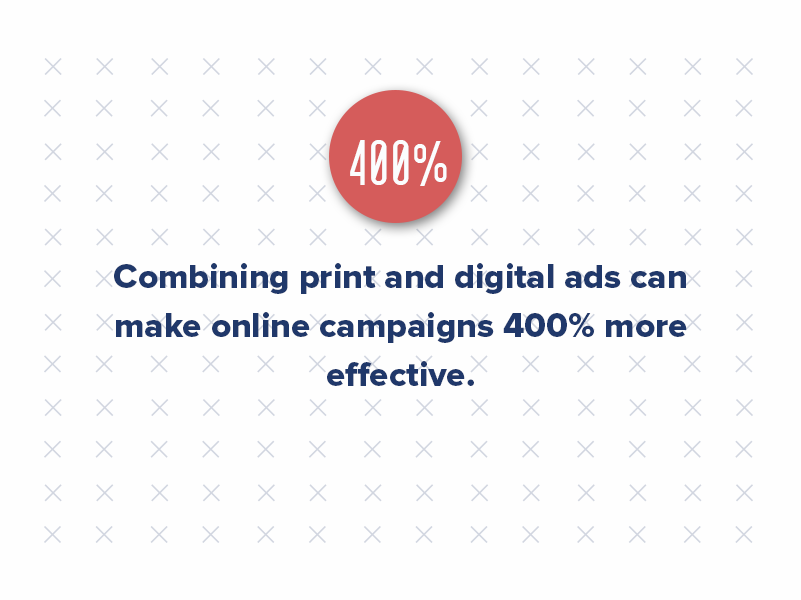
Guerrilla marketing tactics, like distributing eye-catching flyers, can cost-effectively create a buzz. It’s about capturing attention in the real world, sparking conversations, and encouraging people to share their experiences. Remember, tangible interactions can leave a lasting impression in a digital age, and word-of-mouth remains a powerful, cost-free marketing tool.
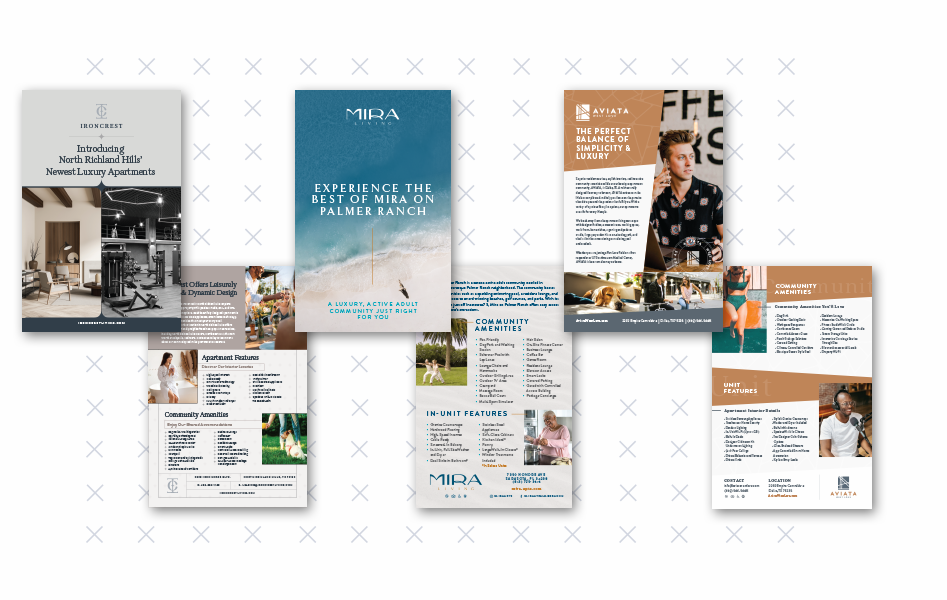
4. Leverage social media (the right way).
Social media offers an expansive yet affordable platform to promote your brand. The key is to focus on quality over quantity. Create content that genuinely resonates with your audience, whether it’s through informative posts, engaging Stories, or interactive polls.
Consistency and timing are crucial. Post regularly, but also strategically, to maximize visibility without overspending. Use analytics to track your performance and refine your strategy based on what works. For example, pay close attention to your audience analytics to know which days and times they are most active online.
5. Encourage word-of-mouth and user-generated content (UGC).
There’s immense value in organic growth driven by word-of-mouth and UGC. Encourage your satisfied customers to share their positive experiences, whether through reviews, social media posts, or referrals. This enhances your brand’s credibility and extends your reach without additional advertising costs. A well-thought-out referral program can further incentivize customers to become multifamily brand advocates.
6. Take advantage of email marketing.
Email marketing continues to be a powerhouse for direct communication with your audience, offering an excellent ROI even with a limited budget. Here are some tips to maximize its potential:
- Segment Your Audience: Segmented emails drive 30% more opens and 50% more click-throughs than unsegmented ones, according to HubSpot. Tailor your messages by segmenting your email list based on demographics, behavior, or their history and interactions with your multifamily brand. This ensures your content is relevant and engaging to each subgroup.
- Personalize Your Emails: Go beyond just using the recipient’s name. Customize content based on their preferences, past interactions, and needs to increase open and click-through rates.
- Craft Compelling Subject Lines: Your subject line is your first impression. Make it catchy, clear, and concise to entice recipients to open your email.
- Optimize for Mobile: With most emails being opened on mobile devices, ensure your design and content are mobile-friendly.
- Use Automation: Automate welcome emails, birthday greetings, and follow-up messages to keep your multifamily brand top of mind without constant manual effort.
- Monitor and Adjust: Regularly analyze your email campaign’s performance. Look at open rates, click-through rates, and conversions to identify what’s working and needs tweaking.
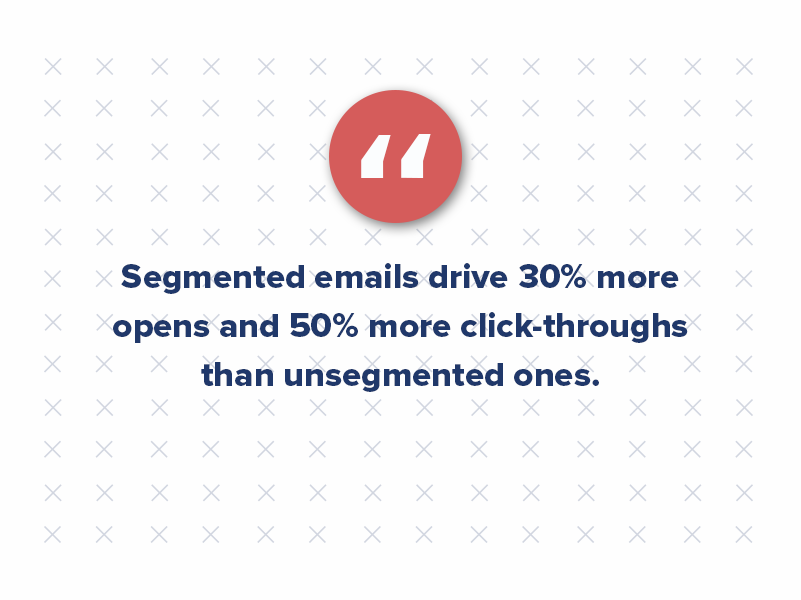
By leveraging these strategies and free email automation tools, you can create effective email marketing campaigns that build strong customer relationships and drive business growth, all while keeping costs in check.
7. Network, collaborate, and get involved in the community.
Building partnerships with other businesses and engaging with your community can open doors to cost-effective marketing opportunities. Consider co-marketing initiatives that benefit both parties, such as joint events or cross-promotions. Participate in local events, contribute to industry publications, and collaborate with like-minded organizations.
Connecting with property management software companies can be particularly beneficial for those in the multifamily sector. PMS companies are asked more often than any other company, “Who should I use for this service? Who does my background checks?” etc. Their salespeople become a referral engine for vendors and affiliate companies in the multifamily space.
Seize the Moment to Thrive in ‘25
As we navigate the mantra of “Survive until ’25,” it’s clear that the multifamily landscape is at a crossroads. While some may view this period as a time of mere endurance, others see it as an opportunity to redefine and invigorate the industry. Unlike any we’ve seen in recent years, the emergence of a buyer’s market signals a shift that could breathe new life into the sector. Yet, the exact timing of this transformation remains uncertain.
In this climate of anticipation, our approach should not be limited to mere survival. Instead, it’s about proactively seeking ways to thrive, even in the face of budget constraints. We can leverage our marketing resources to make a tangible impact by embracing creativity and strategic thinking. Whether it’s through innovative print marketing, targeted social media campaigns, or fostering community engagement, the goal is to find avenues that propel our multifamily brands forward.
This mantra is a call to endure and an invitation to excel. It’s about seizing the opportunities that arise, navigating the challenges with agility, and using every tool at our disposal to ensure that our brands survive and thrive when the industry rebounds.
What Is a Brand Guide and What’s the Proper Way to Utilize It?
Your multifamily brand is more than just a logo or a product. It’s the identity that sets you apart from your competitors and creates a lasting impression on your target audience. But how do you ensure your apartment brand is consistently represented across all channels and touchpoints?
That’s where a brand guide comes in.
Well-crafted brand guidelines can help you maintain cohesive brand identity, streamline your communication efforts, and create a more memorable brand experience for your customers. But implementing a brand guide is not as simple as just creating one.
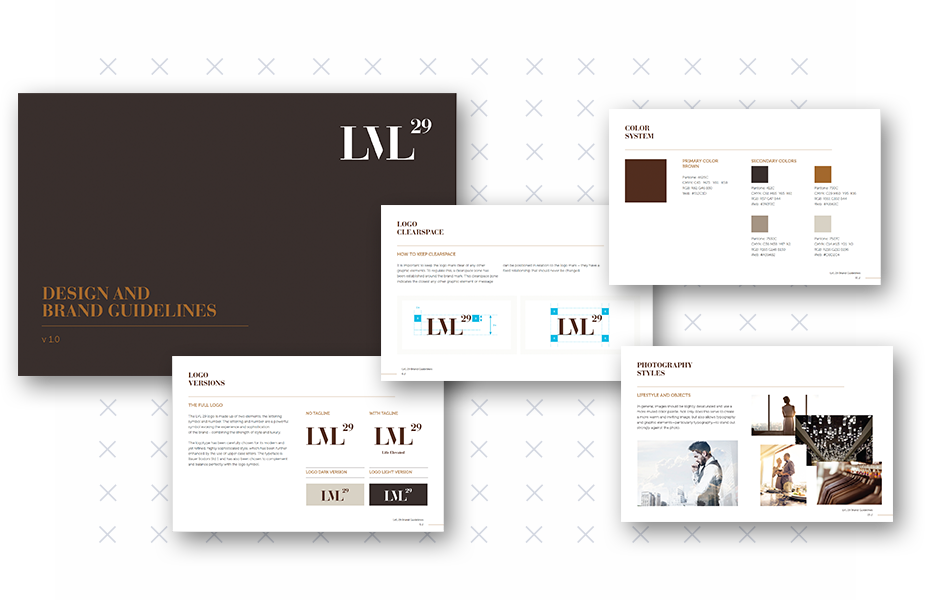
What is a brand guide?
So, what is a brand guide? A brand guide, also known as a brand book or style guide, is a document that outlines the visual and verbal elements that make up your brand. It serves as a reference for your team to ensure that your multifamily brand is consistently represented across all channels and touchpoints. A brand guide typically includes your brand’s mission, vision, and values and guidelines for your logo, typography, color palette, imagery, and messaging. By creating brand guidelines, you can ensure that your multifamily brand is presented cohesively and consistently, regardless of who creates the content.
Why is a brand guide important?
A brand guide is important because it helps you establish a consistent brand identity across all touchpoints. When your brand is consistent, your customers are more likely to recognize and remember your brand, which can lead to increased brand loyalty and trust. In addition, brand guidelines can help you streamline your communication efforts by providing clear guidelines for your team to follow. This can save time and resources by eliminating the need for constant revisions and approvals. Overall, a well-crafted brand guide is essential for any brand looking to establish a strong and memorable identity.
Common elements of a brand guide
A brand guide typically includes several key elements that help define your brand’s identity. These elements may include:
Brand mission, vision, and values
Your brand’s mission, vision, and values are the foundation of your brand’s identity. They define why your multifamily brand exists, what it stands for, and how it operates. Including these elements in your brand guide can help ensure your team is aligned with your brand’s purpose and values.

Logo guidelines
Your logo is the visual representation of your brand, and it should be consistent across all touchpoints. Logo guidelines should include information about the correct usage of your logo, including size, placement, and color.
Typography
Typography is crucial to your brand’s identity, as it can convey a specific tone or mood. Your brand guide should include guidelines for your font choices, including font families, sizes, and weights.
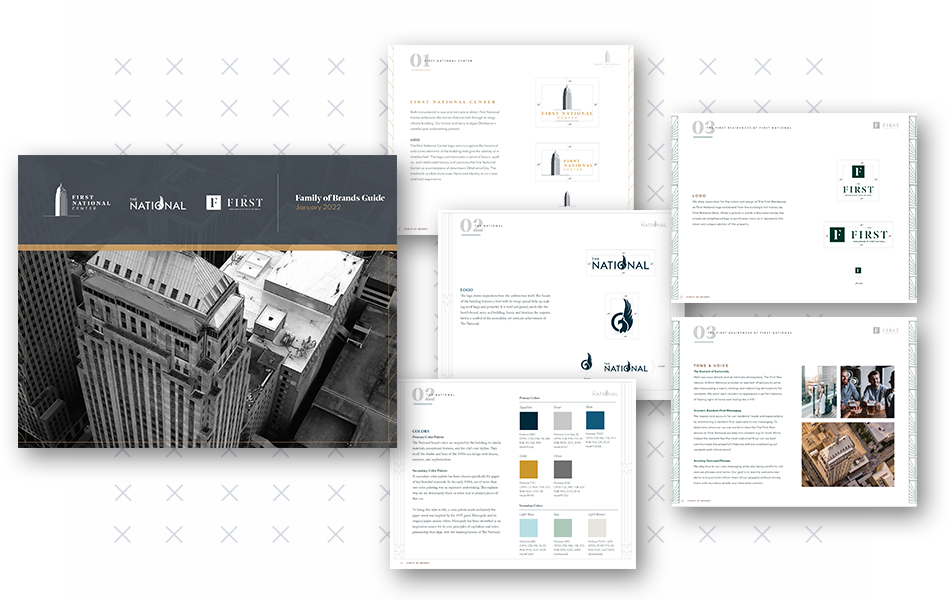
Color palette
Color is another key element of your multifamily brand’s identity, as it can evoke emotions and convey meaning. Your brand guidelines should include your color palette, primary and secondary colors, and any specific color combinations.
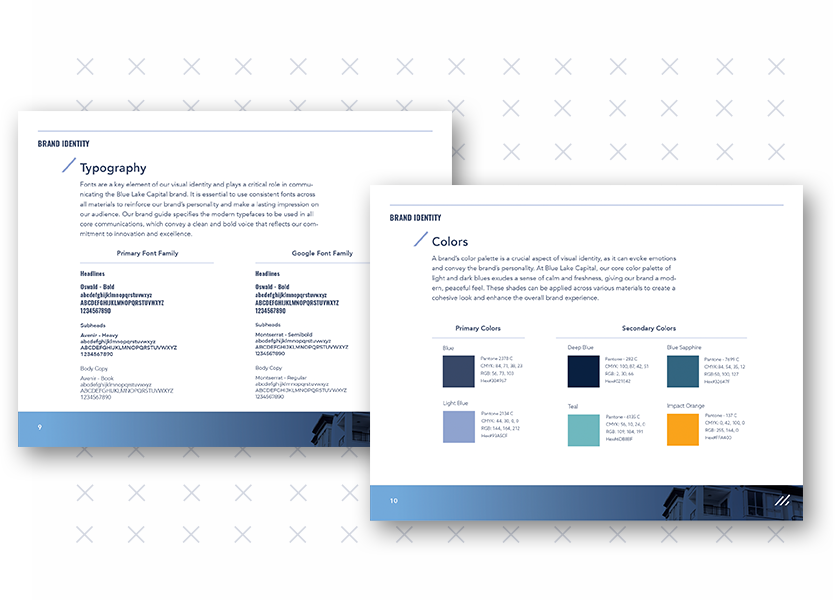
Imagery
Imagery can also play a role in your brand’s identity, whether it’s through photography, illustrations, or icons. Your brand guidelines should include the types of imagery that should be used and any specific styles or themes to be followed.
Messaging
Messaging is the verbal representation of your brand, and it should be consistent across all touchpoints. Your brand guidelines should include your brand voice and tone and specific messaging for different types of content.
Best practices for implementing a brand guide
Implementing a brand guide can be complex, but several best practices can help ensure success. These include:
Creating a brand messaging strategy
Before implementing your multifamily brand guide, developing a brand messaging strategy is important. This should include a clear understanding of your target audience and your brand’s unique value proposition. From there, you can develop messaging that speaks directly to your audience while staying true to your brand’s identity.
Tips for consistent brand messaging
Consistency is key when it comes to brand messaging. To ensure that your messaging is consistent across all touchpoints, consider creating templates and guidelines for different types of content. This can include email templates, social media posts, and advertising copy.
Using visual branding to reinforce your brand’s identity
Visual branding can help reinforce your brand’s identity and make it more memorable for your customers. Consider incorporating your brand’s colors, typography, and imagery into all of your marketing materials, including your website, social media profiles, and advertising.
The role of employee training in brand guide implementation
Your brand guide is only effective if your team understands and follows it. Consider providing training and resources to help your team understand the importance of your brand guidelines and how to use them effectively. This can include workshops, webinars, and training materials.

Measuring the success of your brand guide
Measuring the success of your multifamily brand guide can be challenging, but there are several metrics you can use to track its impact. These may include:
Brand recognition
Brand recognition measures how well your apartment brand is known among your target audience. By tracking your brand recognition over time, you can see how effective your brand guidelines are at creating a consistent and memorable identity.
Engagement
Engagement measures your audience’s interaction with your apartment brand across different touchpoints. You can see how well your brand guidelines resonate with your audience by tracking engagement metrics such as likes, comments, and shares.
Conversion rates
Conversion rates measure how well your marketing efforts are converting leads into customers. By tracking conversion rates over time, you can see how well your apartment brand guide is helping to create a more effective marketing strategy.
Elevate your multifamily brand to the next level
Implementing a brand guide is essential for any multifamily brand looking to establish a strong and memorable identity. By defining your brand’s mission, vision, and values and creating guidelines for your apartment logo, typography, color palette, imagery, and messaging, you can ensure that your brand is consistently represented across all touchpoints. It’s time to maximize the potential of your multifamily brand guide and elevate your brand identity to the next level.
How to Position Your Multifamily Brand to Transform More Leads Into Leases
Your brand is the foundation of your business and can greatly impact how potential residents view your property. With a strong brand identity, you can set yourself apart from other properties and transform more apartment leads into leases.
On the surface, brand identity consists of the name, tagline, apartment logo, typeface, and color palette. But there is more to your brand than these physical traits.
In fact, all forms of messaging run central to your multifamily brand and should reflect the value and perception your company is trying to bring to the market. A brand needs to be carefully crafted to represent your business authentically.
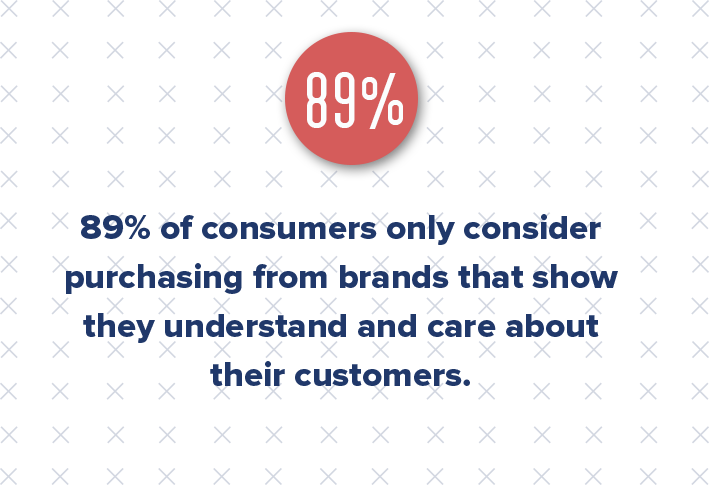
A whopping 89% of consumers only consider purchasing from brands that show they understand and care about their customers — and this is no exception for multifamily. Today’s residents only want to lease from properties they like and trust.
Creating a strong multifamily brand can help you attract and retain residents and drive long-term profitability.
So, how do you position your brand for success?
1. Create a clear vision statement
To start positioning your multifamily branding for success, the first step is to create a clear vision statement that encapsulates your unique value proposition. This should be concise yet meaningful, setting out what makes you different from other properties in the industry while also providing insight into why someone would want to lease from you.
When property management company NE Management was at the beginning of the development phase for its luxury high-rise apartment complex LVL 29, the company needed a partner that could handle the project’s branding and design needs from the ground up.
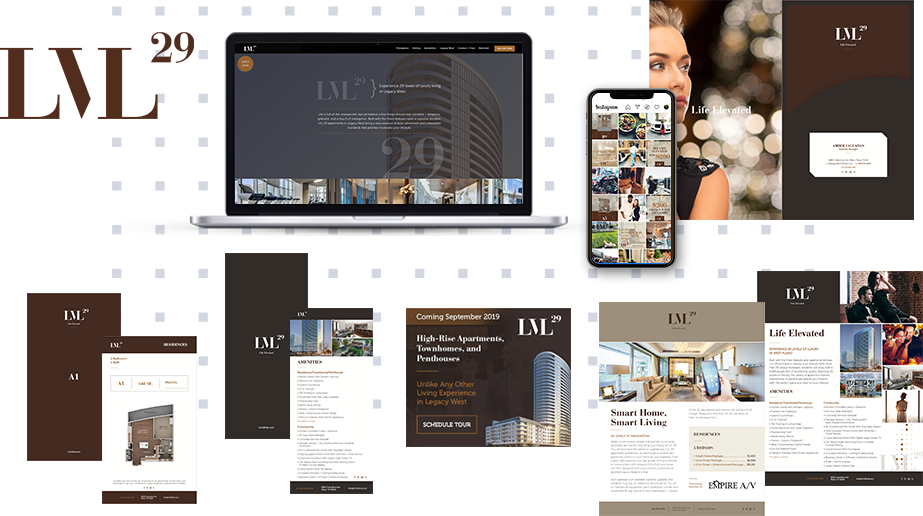
Criterion.B stepped in to help, starting with initial brand development and helping establish a vision and missing statement for the property. Given LVL 29’s luxurious accommodations and sleek design, our agency focused the messaging on buzzwords like elegance, splendor, bold refinement, and indulgence.
2. Develop a plan
Next, develop a well-thought-out plan of attack that focuses on creating a lasting impression and making your brand stand out. This could include using effective visuals to clever copywriting and investing in targeted digital campaigns.
When it comes to building your brand, consistency is key. Everything (colors, font style, etc.) should remain consistent across platforms, including your website and social media channels, so that renters can easily recognize you when interacting with your content online.
For LVL 29, creating a cohesive online and physical brand presence was important. From apartment brochures and rack cards to social media and the website, we wanted LVL 29 to be an easy and immediately recognizable brand that portrayed elegance and sophistication.
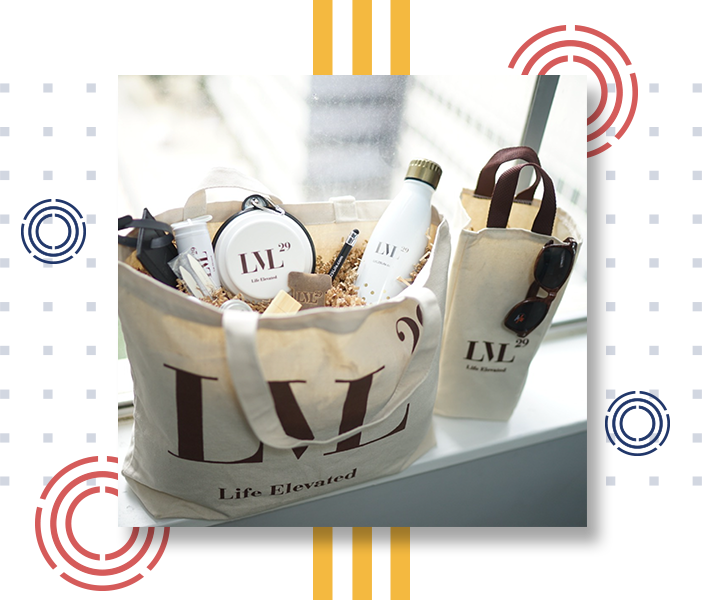
3. Create an experience
Finally, ensure that every touchpoint creates an experience encouraging people to lease from you. From emails to advertising campaigns, each interaction should focus on providing value rather than pushing for a sale immediately. You could do this by promoting your current leasing special in an exit-intent pop-up on your website, offering insightful advice, or running promotions through social channels like Facebook or Twitter.
In fact, due to social media outreach efforts and LVL 29’s overall integration into the surrounding community, current residents are regularly invited to local shops and restaurant events. This has helped boost satisfaction and resident retention for the property.
4. Consult an expert
Here at Criterion.B multifamily marketing agency, we understand how important a strong brand is when leasing properties. And you don’t have to go through these challenges on your own. That’s why we offer our clients comprehensive solutions to help them succeed in the industry.
Criterion.B delivered a full creative branding package for LVL 29, including a website, collateral, brand guide, apartment logo, and promotional materials that reflected the project’s essence and elevated public awareness. After that, digital marketing needs were the top priority. Criterion.B focused on driving consistent, targeted traffic to LVL 29’s website and helped build a substantial and influential social media presence through high-quality branded imagery and messaging.
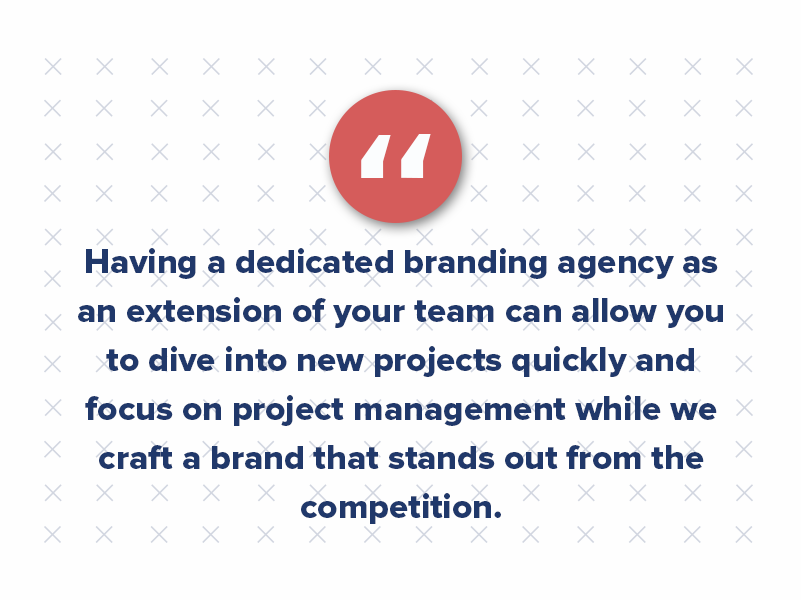
Having a dedicated branding agency as an extension of your team can allow you to dive into new projects quickly and focus on project management. At the same time, we craft a brand that stands out from the competition and naturally attracts residents.
From strategy consulting to multifamily marketing services and more, we have everything you need to transform more apartment leads into leases and position your multifamily branding for success. Contact us today and let one of our experienced team members show you how we can help take your business to the next level.
Position Your Apartment Brand for Success
Following the above-mentioned steps, you can position your multifamily branding for success and transform more leads into leases. A strong apartment brand identity will help set your property apart from competitors, build trust with potential residents, and ultimately lead to greater success in the long run.
Is a Multifamily Rebrand the Best Option for Your Property?
When it comes to multifamily branding, rebranding and repositioning are two popular strategies that owners and developers often use. While they may sound similar at first glance, the two concepts have different implications in the multifamily industry.

What Is a Multifamily Rebrand?
A multifamily rebrand is a strategy that changes a property’s public image and perception. It involves redefining the multifamily brand identity and updating visual elements like apartment logos, colors, fonts, and apartment website design. Rebranding can be used to give an outdated multifamily property a facelift or to appeal to new demographics.
While rebranding can breathe new life into a stale or outdated brand image, it’s a major undertaking. The costs are not only financial but also in terms of time and energy. You’ll need to reassess everything from your website to your marketing collateral to your signage on the property. However, this strategy might be necessary if your property’s current brand is misaligned with your target audience or has a tarnished reputation.
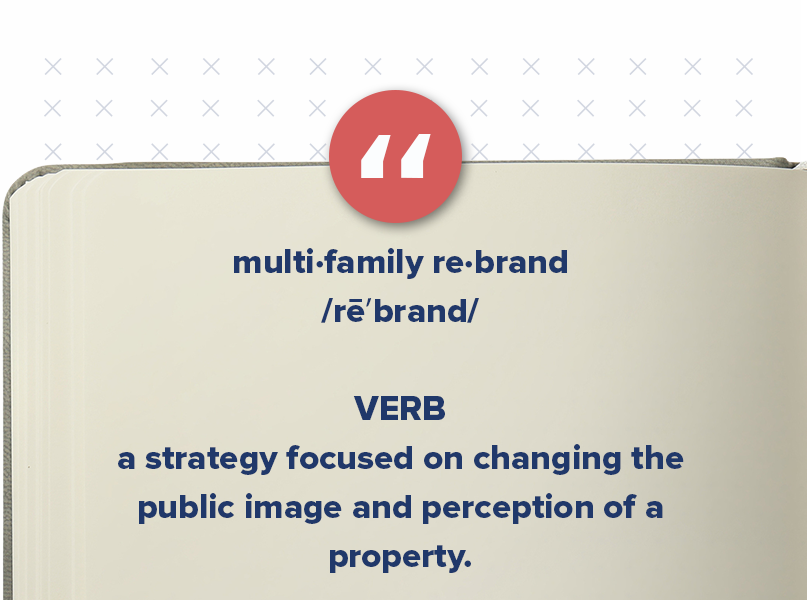
What Is Repositioning?
Repositioning is a strategy focused on changing the positioning of a property in the market. Repositioning typically involves changing the community’s target audience and positioning it against competitors. For example, a property may reposition itself as a luxury community after undergoing significant upgrades and renovations to attract a different demographic.
Repositioning helps tell a new story or emphasize a different aspect of your existing story. While it generally costs less than rebranding, ensuring that the new positioning aligns with reality is essential. Missteps here can lead to unmet expectations and dissatisfied residents.
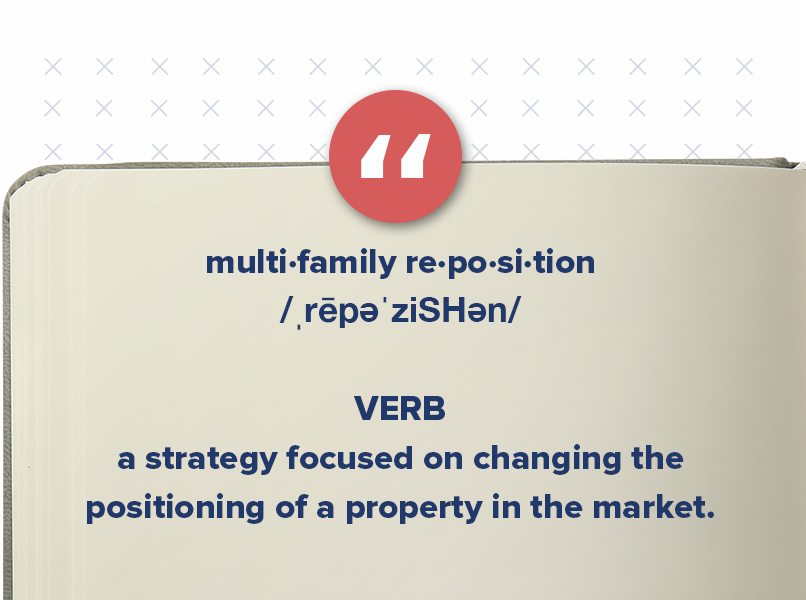
Which Option Is Best for Your Multifamily Marketing Needs?
Rebranding and repositioning are both effective multifamily marketing strategies; however, owners and developers should consider the implications of each strategy before making a decision. Rebranding is often more expensive, time-consuming, and may be necessary when your properties need an entirely new visual identity. Conversely, repositioning involves less work and cost but may not be as effective if done incorrectly.
So, how do you decide? Choosing the right multifamily marketing strategy is important, depending on your needs and goals. Start by evaluating your property’s current market position, resident feedback, and the goals you wish to achieve. Do you merely want to change the perception, or does your brand need a total overhaul? It’s also wise to consult with a multifamily branding agency. They can offer insights and guide your decision-making process.
Sometimes, you might even consider combining a multifamily rebrand and repositioning to maximize your reach and appeal. Ultimately, the choice between the two will depend on each property’s unique situation. You can boost your property’s visibility in the market with the right approach.
Creating a Cohesive Multifamily Branding Strategy
When multifamily owners are ready to rebrand and reposition their properties, it’s important to research current design trends and competitor strategies. As with any multifamily marketing effort, it is important to consider budget constraints, time frames, target audience, and other relevant factors before deciding which strategy to pursue.
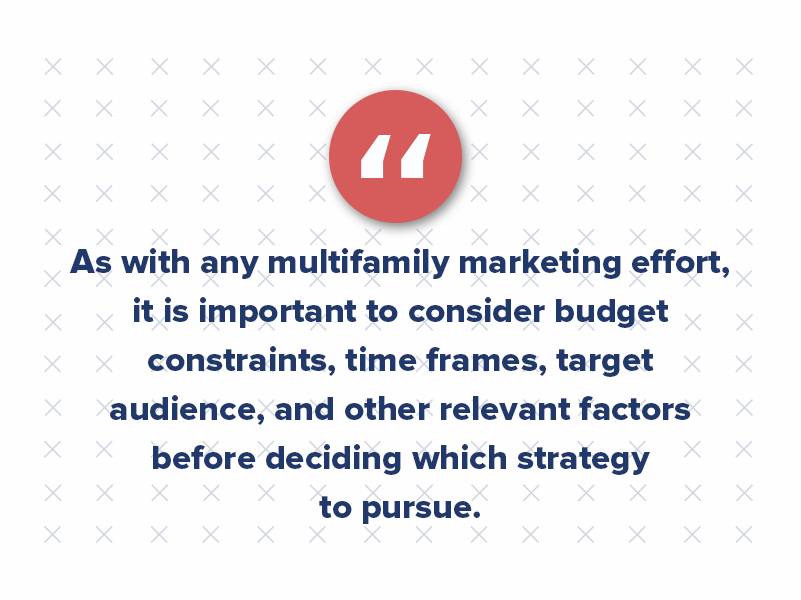
Also, owners should ensure that their multifamily brand is consistent across all platforms, including apartment websites, social media accounts, print materials, and other marketing materials. Finally, multifamily owners should consider working with a professional multifamily branding agency or consultant to help create a comprehensive strategy.
Giving Your Property an Edge With a Fresh New Look
You can create a strong multifamily brand that stands out with a fresh new look and the right positioning. A multifamily rebrand or repositioning can help you increase occupancy rates, attract more apartment leads, and ultimately generate higher revenue when done correctly.
Not all multifamily marketing campaigns require rebranding or repositioning, but understanding the differences between the two can help you make informed decisions about your marketing and branding needs! To learn more about a multifamily rebrand, contact us today. We can help you develop a multifamily marketing strategy tailored to your unique goals and needs.

Handle Your Apartment Branding Challenges With Ease Using These Tips
Your multifamily brand is one of your most important assets. It’s a way for residents to connect with your property and differentiate you from competitors. Your identity and residents’ perception of your brand are among the driving forces behind their decision to lease at your property.
In fact, 89% of consumers only consider purchasing from brands that show they understand and care about their customers. Today’s consumers only want to purchase products or services from businesses they like and trust.

Creating and maintaining a strong multifamily brand can help you attract new residents, increase occupancy rates, and drive long-term profitability.
So, how do you turn your brand into a high-performing asset with loyal customers?
Why Does Your Multifamily Brand Exist?
First, determine your purpose and examine how your identity affects your property — internally and externally. Your success hinges on consistency, hard work, and a long-term strategy.
Keeping your message aligned with your mission and core values helps your residents understand your property. This helps build trust, optimism, and clarity and is integral to long-term success. However, it’s important to understand why your property exists to keep your message authentic. Who is your target audience? What difference are you trying to make for them? A purpose-driven message should be the foundation upon which your brand is built.
Making money is an important goal for any property management company. Still, the companies that place more importance on service and community — rather than profitability — are the ones who foster the strongest resident experience.
For example, Chick-Fil-A emphasizes that the company is about more than its delicious breaded chicken sandwiches. The fast-food giant upholds strong family and Christian values and has a corporate commitment to putting the happiness of customers and employees before profits. In 1946, Founder Truett Cathy closed the restaurant on Sundays to allow employees to rest or worship if they choose — a practice Chick-Fil-A still upholds today.
Chick-Fil-A’s approach appeals to many customers because it demonstrates the business’ commitment to the communities it serves and to providing value beyond the point of sale.
1. Set your goals.
Before you can turn your multifamily brand into a high-performing asset, you must first set clearly defined business goals. They should be attainable, measurable, and focused on the big picture.
Do you want to position yourself as an innovative leader? Are you trying to attract more customers? These goals should give your multifamily brand direction for growth.
2. Define your brand.
Before you can start building your multifamily brand, you need to define what it is. What are your core values? What do you want your tenants to think of when they see your property?
Answering these questions will help you develop a clear and consistent message that you can use across all your marketing channels.
3. Create a strong visual brand identity.
Your multifamily brand’s visual identity should be unique, memorable, and reflective of your property’s personality. Your apartment logo, website, and multifamily marketing materials should all be cohesive and on-brand.
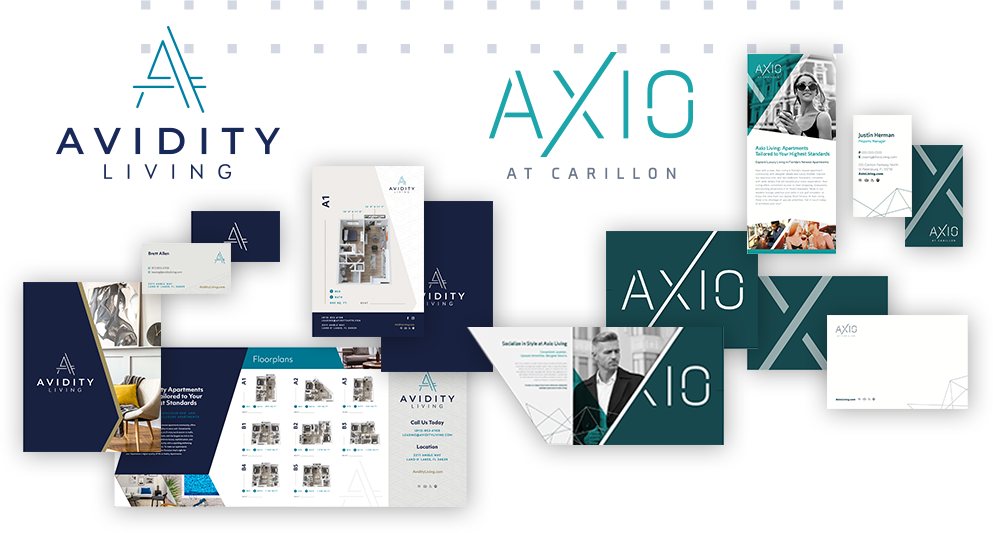
4. Build brand trust.
Brand trust is essential for multifamily properties. After all, your residents are entrusting you with their homes. A few key ways to build brand trust include being transparent, delivering on your promises, and providing excellent resident service.
Start by reading and responding to all resident reviews, especially the negative ones. It’s critical to respond to those reviews promptly, make changes, and bury the bad reviews with good ones through consistent and reliable customer service.

5. Promote your brand.
Once you’ve developed a strong multifamily brand, it’s time to start promoting it. There are several ways to do this, including content marketing, social media marketing, and email marketing.
By promoting your brand consistently, you’ll be able to reach a wider audience of potential residents and build long-term relationships with them. A full-service multifamily branding agency can help you with this by providing campaigns, social media management, email workflows, and more.
Integrate Your Multifamily Brand Into Everything You Do
The key to any successful multifamily brand is internal and external consistency. In other words, you should integrate your messaging and vision into every aspect of the business. It should be visible and reflected in everything your customers and employees see, hear, or read.
If a customer walks into your headquarters, your apartment logo should be displayed, and your staff should interact with customers, clients, and vendors with your core values. On your company website, make sure to incorporate your unique voice, personality, and messaging into the content.
As your business grows, your target audience will change, and evolving in unison is important. Maintaining relevant, consistent messaging takes time, resources, and commitment. Your brand is an investment, and we’d love to help you maximize it.

Learn the Expert Secrets Behind Apartment Logo Design
Arguably the most important feature of any branding effort, apartment logo design is an oft-misunderstood art.
Logo design isn’t as simple as sketching at random and hoping for the best, nor is it simply waiting for inspiration to hit you out of the blue. Apartment logo design should be strategic, thoughtful, and yes, even aesthetically pleasing.

When branding for multifamily, logos can often become complex — the logo not being just the extension of the building or its amenities but also of the community, the culture, and the reputation. In short, branding a multifamily project is critical to its success.
There is no easy way to ensure your multifamily branding project will bring the success you desire; however, there are three simple steps you can take to ensure your logo design is as successful as possible:
1. Concepting Your Idea
Establish the “feel” first. What kind of organization are you designing for? Obviously, as a multifamily development, you may have different brand needs than a hip new restaurant, but dig even further than that. Know your property and which people need to be involved.
Things to think about include:
- What is the internal culture?
- What is the public-facing culture?
- What separates you from other similar properties?
A great way to answer all these questions is to start with word exercises; a mind map can help you make a connection you didn’t see at first. All of these elements need to be represented in some way with the brand as a whole.
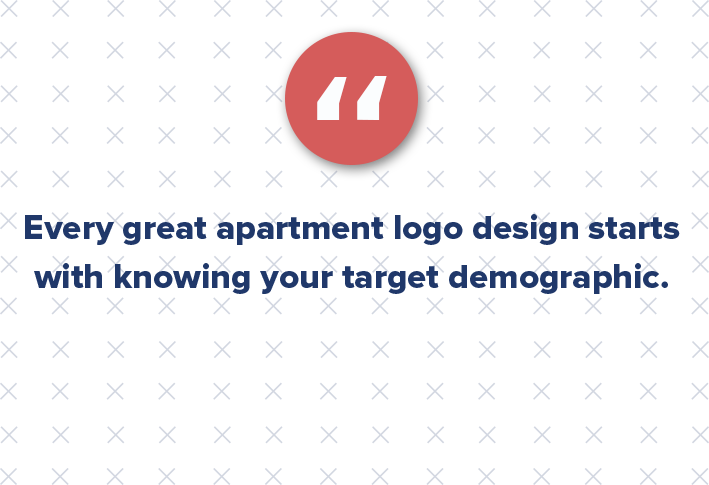
Every great design starts with knowing your demographic as well. You also need to ask yourself: who, what, where, when, and why.
- WHO: Who is your property? Who is your competition? Who is your target audience?
- WHAT: What differentiators does your property offer? What are you trying to achieve or what emotion are you trying to evoke?
- WHERE: Where is the property located?
- WHEN: When will the property be ready for leasing?
- WHY: Why should residents rent here and not another property?
If you followed the multifamily inbound marketing strategy correctly, your teams all came together to identify your buyer persona. Doing this should have resulted in defining your lead lifecycle stage and identifying the answers to all the above questions.
If you have not done this, go back and do it now because this data is vital to your brand identity.
The apartment logo is one of the first aspects of your property that people see, and it shows on every piece of a multifamily brand. Be sure to make a good first impression.
2. Just Keep Sketching
Sketch, sketch, sketch. It’s highly unlikely that any great (or even good) apartment logo design has ever been developed start-to-finish on a screen. Pencil and paper are still the best free-form way to get ideas started.
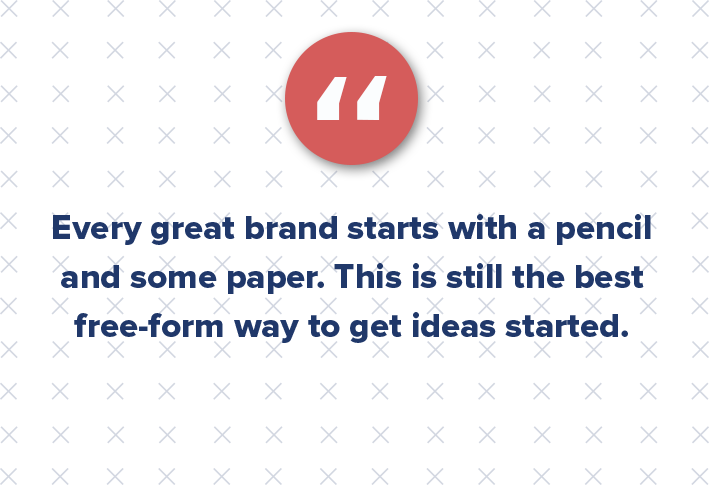
Remove any ideas of “pixel perfection” or perfect lines and fully rendered visuals, as this allows you to think more fluidly and discover ideas that might have been missed if the first step were to fire up Illustrator.
Only after sketching, more sketching, pulling the interesting ideas out from the boring ones, and refining the sketches should you turn to your software tools. That apartment logo should be designed in the program of your choice that allows for fully scalable vector art. Designing something in pixels in Photoshop might be fine for now, but what happens when that apartment logo needs to be scaled? Always be conscious of future needs.
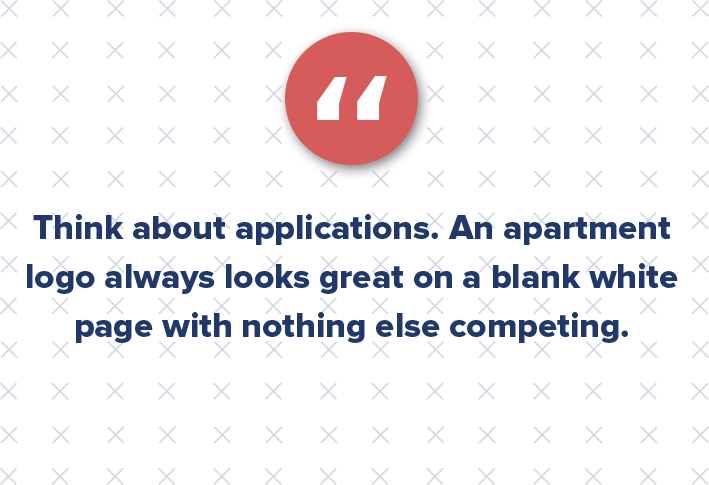
Think about applications. An apartment logo always looks great on a blank white page with nothing else competing. Consider the following:
- How is that mark going to be used?
- Does it look good in a one-color variant for black-and-white printing?
- What about reversed out over a dark background?
- How much clearspace does it require not to get lost in a busy application?
- What if it needs to be really large or really small?
- Does it scale well?
3. Presentation Is Everything
Presentation is key. Whether you are presenting the apartment logo to the property management team, owners, or other marketing team members, your logo should be presented without any ornamentation or competing elements — then show the applications. Black, white, and alternate brand colors — if providing a logo system.
Mockup major applications, like signs or collateral. The presentation needs to show the main applications in a way that allows everyone to really visualize how the new apartment logo fits into and helps the property’s brand position.
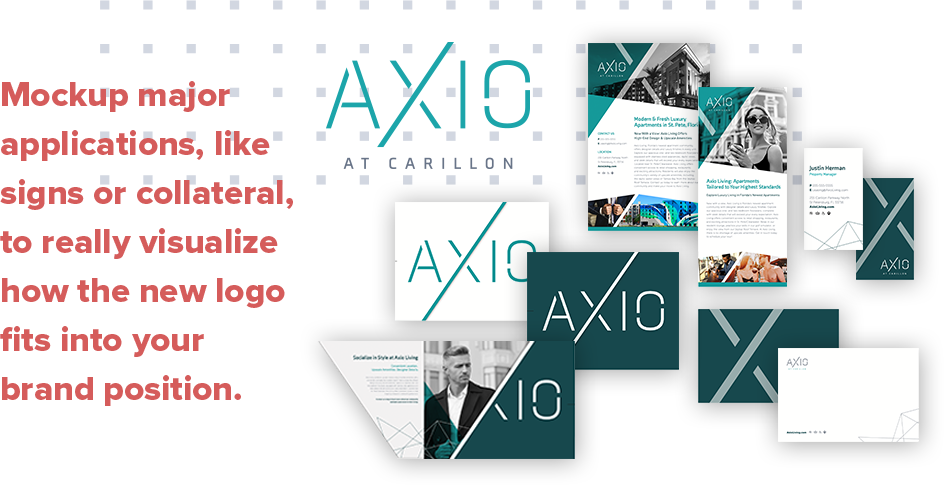
Building a Successful Multifamily Brand
Creative pursuits are fun and exciting because processes can vary from person to person. While this process is not the only way, it’s rather important to have some semblance of a process that brings you to the place where your creative output is best. Not only does your creative need to be strong, but you have to have a strategy in mind for what makes an apartment logo design work and why it will help your brand become successful.
Think about apartment logo design like a cross-country trip. If “creative” is the destination, that makes “strategy” the journey. You can’t arrive at your final destination without going on a journey first.
Properties that achieve great multifamily branding find great success. And you don’t have to start this brand journey on your own. Our multifamily marketing agency is here to help! We’re experts on multifamily branding and apartment logo design, so you can focus on building your property (and leases), while we build your brand.

Why You Should Invest in Professional Multifamily Branding Services
Multifamily branding is not just a “destination.” But it’s also not just a “journey.”
We’ve said it before, and we’ll say it again: multifamily branding involves way more than an apartment logo or flowery brochure.
It’s about telling a brand story that resonates with your residents, building a brand identity that stands the test of time, and creating an honest brand from the inside out that your residents and prospects will trust.
If you want to be on the right side of multifamily branding, you need to invest in the services of a professional multifamily branding agency.
Hiring a top-tier multifamily branding agency can be stressful. We know from our clients that deciding to bring on an outside agency in the first place — let alone deciding which one to hire — is a big decision.
First, it’s a marketing cost you might not have included in the initial budget. Secondly, shifting work on something as integral to a property as its multifamily brand raises fear of losing control to a team not in your property management office.
Key to making a case for hiring a multifamily branding agency is recognizing that an agency with the right experience and creativity will help generate more apartment leads in the long run and can be one of the most important investments you make.
Here are a few more reasons why hiring our multifamily branding agency to take you on this branding adventure (or “brand-venture,” if you will) could be the best decision you’ve ever made for your property:
1. We’re truly passionate about multifamily.
Criterion.B is a digital marketing and branding agency specializing in the multifamily industry. We got our name in 2017; however, our story began nine years earlier in 2008. Known as Canonball Creative at the time, we started as a digital agency serving ad agencies. Digital marketing was starting to take off, and the larger agencies needed help navigating the market. This provided us with invaluable experience as we worked on some of the world’s largest brands, including Coca-Cola, McDonald’s, Samsung, and Pepsi, to name a few.
We specialized in building out difficult online assets in a way that would stay true to the agencies’ rigid creative guidelines. By 2014, we had already worked with a few big names in the multifamily market, such as Amli and UDR, due to the relationships we made through our ad agency connections. Then, we decided to pivot into building our direct client base focusing on multifamily.
Over the next few years, we invested heavily in the multifamily industry. We attended every conference we could find, joined associations, wrote for as many association publications as we could, interviewed key marketing professionals on the client side, and wrote hundreds of blogs focused on multifamily marketing.
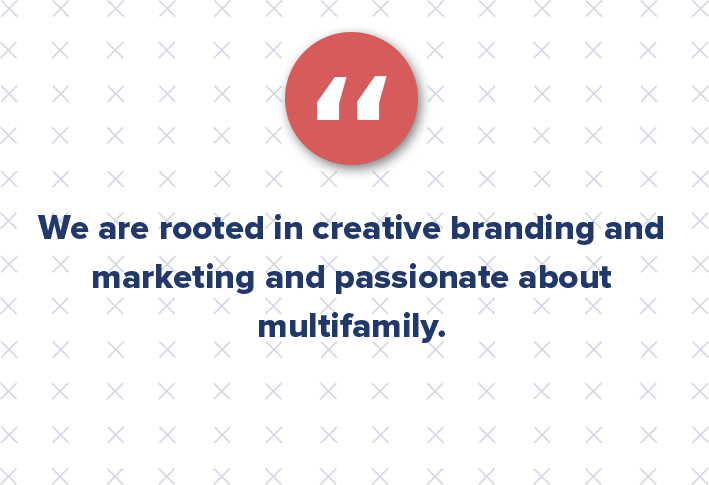
In 2017, we made it official by changing our business name to Criterion.B and pivoting our focus entirely to serving the multifamily market.
In short: We are rooted in creative branding and marketing and passionate about multifamily. The perfect pairing makes us the perfect partner for your property.
2. We’re backed by the best clients.
Whether you need marketing collateral designed and printed, new swag for your property, or a full brand development package, our multifamily branding agency is ready to serve as an extension of your team to ensure consistency and positive results.
We don’t work for our clients; we work with them to create an honest, recognizable, and beautiful brand from the ground up.
Take NE Development as one example. NE Development is a premier multifamily developer in the North Dallas area. Their high-rise project in Dallas’ exploding Legacy West area, LVL 29, offers luxury living. Criterion.B has worked with NE Development from the early phases of the project to the high-rise coming online in early 2019 — through to today.

Our multifamily branding agency was tasked with helping NE Development inspire elegance, splendor, and a touch of indulgence in all brand elements of LVL 29, from naming and brand development to website, collateral, social media management, and signage design.
Criterion.B has worked with the LVL 29 team from groundbreaking and development to lease-up and beyond. From building the brand elements to managing social media content, we continue to help LVL 29 grow to new heights — and it all started with building a bold brand.
3. We offer more than just one-off multifamily branding projects.
Are you looking for a jack-of-all-trades agency that specializes in precisely what your property needs? You’ve come to the right place.
We know that a great brand and name is recognizable, unique, meaningful, and can stand the test of time; it goes beyond just the apartment logo stamped across promotional items. Through research and brand strategy, we help build a multifamily brand that connects with your customers.
At Criterion.B, we take your mission, vision, and goals and translate them into a design that will fuel the direction and growth of your new property. Investing time into developing your multifamily brand will align your internal and external audiences and drive tangible results to your bottom line.
Here is a quick snapshot of the multifamily branding services we offer:
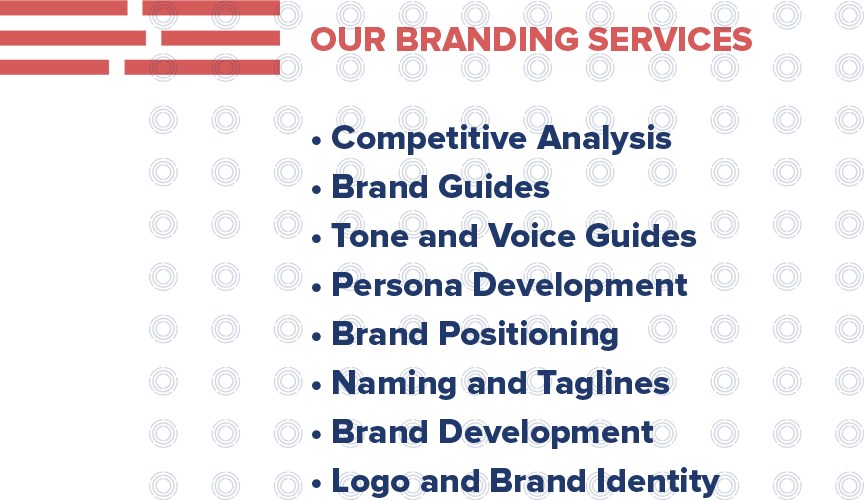
4. We bring 100 years of combined experience to the table.
A passionate team of creative professionals backs our multifamily marketing agency. We specialize in multifamily branding new developments from the ground up. Ultimately, we believe in building your brand into one that residents can trust and love.
We’ve seen a thing or two as professional marketers with more than 100 years of combined experience. We know what makes your organization tick and the best branding elements to edge out the competition. We are passionate about creating a brand that exceeds your expectations (and ultimately your goals) because your success is our success.
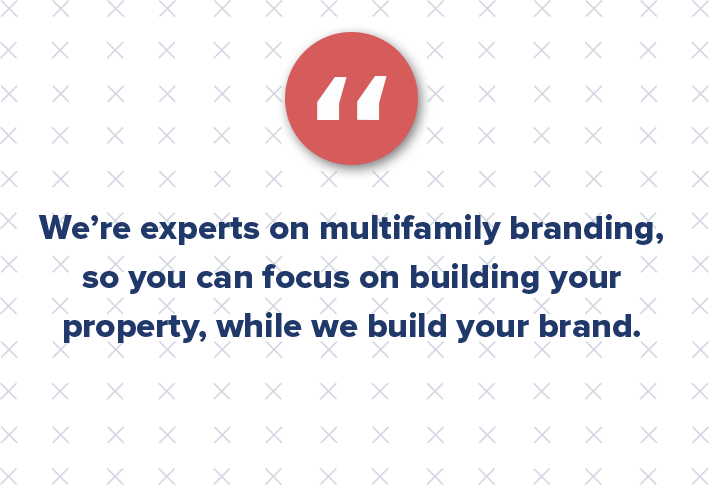
Essentially, we’re experts on multifamily branding, so you can focus on building your property (and leases), while we build your brand. No muss, no fuss, no hassle!
5. We understand that branding is about the journey AND the destination.
At Criterion.B, we maximize the multifamily branding potential of your real estate portfolio — whether as a developer, investor, owner, or property management company. Our passion is to blend restless creativity with remarkable multifamily branding to drive awareness and apartment leads to your property.
We’re here for you with anything you need — whether that be branding and marketing help, printing, or even just a friend to brainstorm ideas with.

Building a multifamily brand is a journey that must be traveled (no matter how complex it may be), and we were built for this adventure.
How to Identify and Leverage Your Multifamily Brand Storytellers
What is a multifamily brand?
A multifamily brand is a promise for all stakeholders and the inspiration that should drive you to do your best. It is essentially a filter for making business decisions.

As a marketing and multifamily branding agency, we conduct an unofficial survey on the perceptions of branding every time people ask us what we do.

Many things about a multifamily brand are visual. Design elements, fonts, and colors can evoke a property’s look and feel with just a first impression. And yet, this narrow thinking — or rather, misconception — about what a brand entails is why so many people in real estate are failing to connect with their audience and with a growing millennial and Gen Z demographic.
More Than an Apartment Logo
Multifamily branding is more than a recognizable name and emblem. A brand’s value can be found within the associated perceptions and emotions that it conveys.
Let’s take the Nike swoosh, for example. On its own, Nike’s logo is quite simply a checkmark (that’s the extent of its complexity). And yet, we associate that “checkmark” with concepts and values far beyond itself.
Simply placing the Nike swoosh on a product represents a promise of quality. We associate the swoosh with images of athletes, perseverance, and passion. The final minutes of a championship. The strength and talent are only earned through hard work.
That’s a pretty powerful “checkmark.”

Take any other well-known logo — The Ritz Carlton, Whole Foods, BMW, etc. — and consider what kind of brand images and emotions it triggers. These perceptions, whether consciously or not, guide consumer purchase decisions.
Now apply the same principles of perception to multifamily branding — like a luxury high rise or a neighborhood community.
What brand images are associated with your property? What architectural vision or lifestyle is conveyed?
Creating an Honest Brand From the Inside Out
Our challenge as a multifamily branding agency is finding out how to create a brand experience that resonates with the consumers. We want the experience to be echoed back to the customer in the visuals. The best way to build brand loyalty is by creating an honest brand. Open lines of communication between designers and leaders of the company are essential to designing honestly.
Good brands start from the inside out. The leaders create the vision. The vision creates the visual language. And the visual language turns into a system that is unified enough to be recognized as a cohesive brand. In this way, every communication of the brand is unified, from the way the CEO talks about the company, to the visual language, to the customer service.
How to Better Control Your Multifamily Brand Story
As a multifamily branding agency, we are tasked daily with creating or furthering a story for the brands we represent. However, so often, that story is thought of as one to be consumed via TV, radio, print, outdoor, or the web.
Sure, we all talk about mobile, building responsive websites, useful apps, etc., but it’s not often that we focus specifically on mobile storytelling.

As digital marketers, we pride ourselves so much on our ability to tell a brand’s story, but in reality, we have very, very little control over what that story is.
So, who are your brand storytellers? And how do you approach each of them?
- Your brand → Your brand should always communicate the “why.” People don’t buy what you do, but rather why you do it.
- Advocates → You have to recruit influencers, inspire them to keep advocating for your brand, and reward them for doing so.
- Fans → Your fans like your brand, and hopefully, you’ve been able to build a community around them. But these people aren’t brand advocates just yet. Give these people props when they do talk about your brand, and hopefully, you can convert them into advocates.
- Haters → Your haters will always be there, no matter the industry in which your brand exists. However, you really need to listen to these people and heed the things they are saying about your business, even if you don’t want to hear it. Engage with them, and make them like you.
In order to fulfill all of this, brands need to figure out how to tell the story from the middle.
Traditionally, stories have a beginning, middle, and end. But, with social media, your multifamily brand is constantly having to keep up. You should tell your story from the middle, in the “right now.” There is never an end.
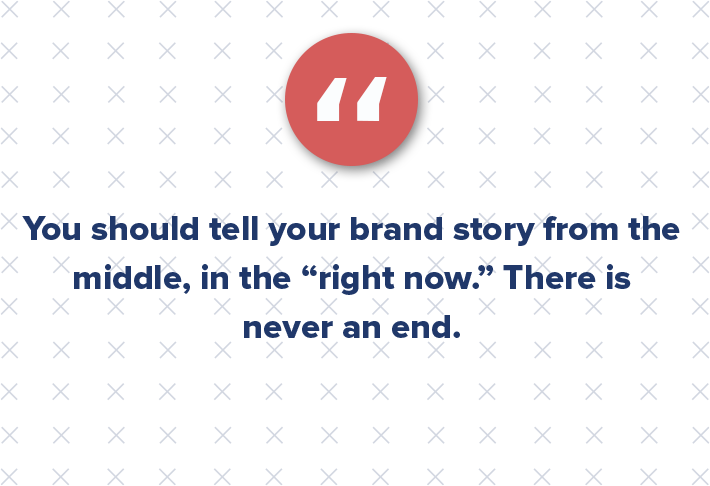
Finally, brands need to know which kinds of stories to tell. Tell a story that is inspiring, entertaining, or trending. Tell stories of how your brand cares, and most importantly be human.
Real Estate’s Roadmap to Nike
We’ll let you in on the secret to Nike’s brand success: it was deliberate. In the early stages, the company sat down and asked themselves:
- What is Nike?
- Who are our customers?
- If Nike was a person, what kind of personality traits and values would he or she internalize?
Every great brand has a plan. And in a crowded market, a great brand can resonate and differentiate.
Multifamily branding is more than an apartment logo — it’s an emotional experience, a taste of a lifestyle, and a framework through which to grow.
The first steps of multifamily branding may seem like silly introspection, but don’t be fooled. Building blocks can seem quite simple, until one day they’re a building.





